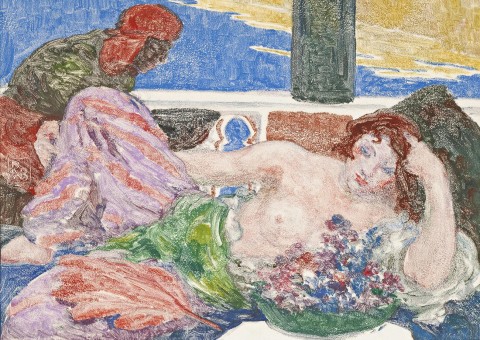ODALISQUE, c.1921
RUPERT BUNNY
monotype on paper on card
24.0 x 34.0 cm
signed with artist’s monogram centre left: RCWB
Galeries Georges Petit, Paris
Private collection, Normandy, France
Christophe Joron-Derem, Drouot, Paris, 27 June 2018, lot 197
Private collection, Sydney
Probably: Exposition Rupert Bunny: Monotypes, Galeries Georges Petit, Paris, 16 – 31 March 1921, cat. 41
Probably: Exposition de Monotypes par Rupert Bunny, Galeries Georges Petit, Paris, 16 – 30 October 1924, cat. 32
Rupert Bunny’s monotypes of the early 1920s are among his most original works, much admired when first exhibited in Paris. The art critic for Le Temps described them as ‘most pleasing to the eye’, with ‘arabesques of gently rhythmic grace, that highlight the beautiful accents of colour which is always rich and harmonious’.1 Among the numerous scenes Bunny drew from the harem, the bold forms and hot colours of Odalisque, c.1921 show the striking influence of Henri Matisse as well as the passion for things Eastern that had engulfed Paris. Others are closely related to his paintings of mythological decorations of the time, celebrating a lifelong interest in classical mythology. The monotype Le Retour de Perséphone, c.1921 provides a reverse image of the oil painting (previously in the collection of the Bunny connoisseur Dr Ewan Murray-Will) and an oil sketch of the same subject. The tale of Persephone and story of the advent of the seasons, especially spring, appealed greatly to Bunny, seen at its best in his masterpiece in oil, The Rape of Persephone, c.1913 (collection of the National Gallery of Australia, Canberra). Luminous and inventive of design, these two monotypes on offer have particular appeal through their newness to the market, previous French whereabouts being unknown.
1. ‘Art & Curiosité – Les Monotypes de Rupert Bunny’, Le Temps, Paris, 23 March 1921, p. 3
DAVID THOMAS
